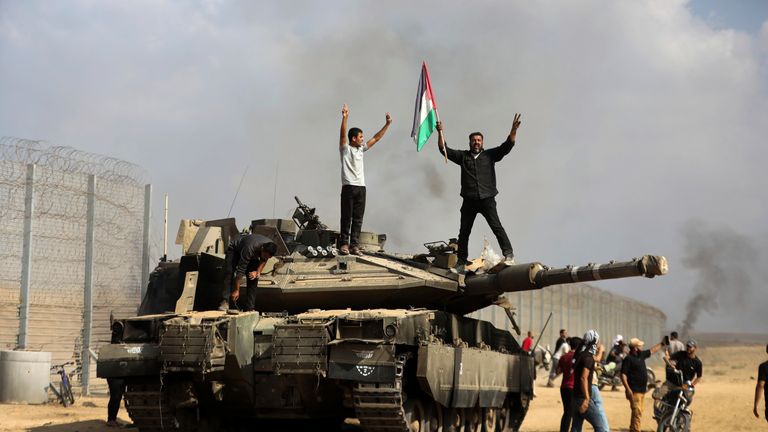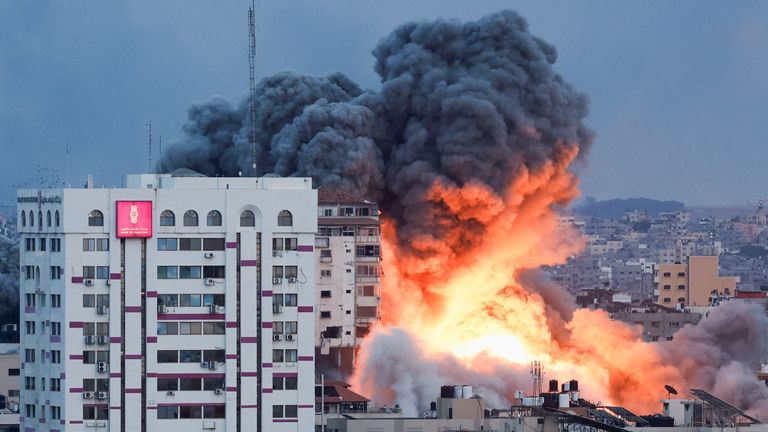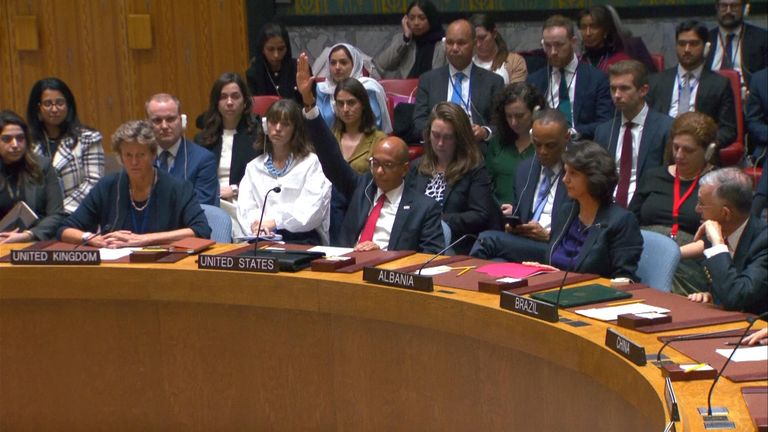After months of conflict and tens of thousands of deaths, fighting continues between Israel and Hamas, with the Middle East appearing to be on the brink of a wider war.
In this story, Sky News looks back at what has happened between the Hamas attacks on 7 October 2023 and the same date a year later.
The renewed conflict has raged for months and has seen an escalation between Israel and Iran and the most dangerous situation on the border with Lebanon for many years.
What follows is by no means an exhaustive timeline, but it aims to capture some of the more salient moments in the devastating conflict.
Hamas attack and Israeli retaliation
On 7 October, Hamas gunmen launch an attack on southern Israel, rampaging through communities and killing 1,200 people.
Some 250 people are taken back to Gaza, according to Israeli tallies, where they are held captive. The status of the hostages becomes a central issue of the renewed conflict.
Prime Minister Benjamin Netanyahu declares that Israel is at war and orders airstrikes on Gaza, along with a total siege of the densely populated territory.
Israel ground offensive into Gaza
On 13 October, Israel tells residents of Gaza City, where more than a million people live, to evacuate and move south.
The same day, Israel Defence Force (IDF) troops move into the Gaza Strip in what is described as a raid.
An explosion at the al Ahli hospital in Gaza City on 17 October triggers outrage in the Arab world, but there is disagreement and confusion about who is behind it.
Later the same month Israel launches its large-scale ground assault on Gaza, marking the beginning of its invasion of the territory.
Al Shifa hospital
On 15 November, Israeli troops enter Gaza’s biggest hospital, al Shifa, in Gaza City, after a siege lasting several days during which medical staff say patients including newborn babies died from a lack of power and supplies.
The IDF says the hospital has been used to conceal an underground Hamas HQ, a claim that hospital staff deny.
Within a few more weeks, all hospitals serving the northern half of Gaza cease functioning.
November ceasefire
After weeks of fighting, Israel and Hamas announce the first truce of the war. They agree to pause fighting for four days to exchange women and child hostages held in Gaza for Palestinian women and teenagers detained or jailed by Israel on security grounds, and allow in more aid.
The ceasefire would eventually be extended for a week in total and lead to the freeing of 105 hostages and about 240 Palestinian detainees.
War resumes on 1 December. Days later, Israeli forces launch their first big ground assault on southern Gaza, on the outskirts of the city of Khan Younis.
On 6 December, 22 members of the same family are killed in an Israeli airstrike at the Jabalia refugee camp in northern Gaza.
Two days later, the US vetoes a UN Security Council demand for an immediate humanitarian ceasefire. The UK abstains.
On 15 December, three Israeli hostages are killed by IDF troops who mistakenly open fire on them.
Two of them are killed in an initial volley of gunfire, while the third dies 15 minutes later after being urged to come out by the IDF and is then fired upon.
US and Britain launch airstrikes on Yemen
Continued attacks on Red Sea shipping by Houthi rebels during this time cause major concerns for international trade.
On 11 January 2024, the US and UK launch dozens of airstrikes across Yemen in retaliation.
The Houthis say five of their fighters have been killed in the initial strikes, and vow to continue their attacks on shipping.
On the same day, the International Court of Justice hear opening statements in a case in which South Africa accuse Israel of committing a state-led genocide campaign against the Palestinian population. Israel denies the accusation.
Death toll surpasses 30,000
On 22 January, 21 IDF soldiers are killed in central Gaza in a single incident – the deadliest day for Israel’s forces since the war began.
At the end of February, the Hamas-run health ministry in Gaza says the number of deaths in the territory since 7 October has risen above 30,000.
It says most of those killed are women and children and warns that the real figure is likely to be higher.
At this time there is widespread international concern about Israel’s plan to launch a military offensive into the southern city of Rafah, where more than a million people are sheltering.
The UN warns that a famine is imminent in northern Gaza and says 1.1m people are starving.
On 1 April, seven aid workers from World Central Kitchen are killed in an Israeli military strike in Gaza. Three British nationals are among the dead.
An Israeli investigation finds that incorrect assumptions, decision-making mistakes and violations of the rules of engagement had resulted in their deaths.
Iran and Israel trade salvos
Escalating tensions between Israel and Iran boil over in April.
Tehran alleges that an Israeli strike on its embassy in the Syrian capital, Damascus, has killed several Iranian officers including a top general.
In retaliation it launches a barrage of dozens of missiles and drones at Israel on 13 April. The vast majority are intercepted.
Amid international concern about a regional crisis, Israel responds by striking a number of targets in Iran.
Tehran plays down the impact of the attack near a major military airbase and a nuclear site in the central city of Isfahan, but satellite photos suggest an air defence radar was hit.
Also in April, tens of thousands of people take part in anti-government protests in Israel, urging Mr Netanyahu to reach a ceasefire deal for the release of hostages. It follows months of other demonstrations against the government.
May: Negotiations in Cairo fail to produce ceasefire
Talks in the Egyptian capital aimed at getting Israel and Hamas to agree terms for a ceasefire come under the spotlight in early May.
Hopes of a breakthrough when Hamas announce it has accepted a ceasefire proposed by Egypt and Qatar are dashed after an Israeli official called it a “ruse”.
People on the streets of Rafah celebrate after Hamas’s announcement, but hours later the Israeli military says it is conducting strikes in the city.
Outcry after strike on Rafah kills 45
There is international outrage after an Israeli airstrike on Rafah kills 45 people in late May.
According to Palestinian medics, the strike hits tents for displaced people and Hamas-run authorities in Gaza say “most” of the dead are women and children.
Mr Netanyahu says it was a “tragic mistake”, while the head of the UN agency for Palestinian refugees says the city has become “hell on earth” following the deadly strike there.
Hostage rescue amid heavy death toll
In early June, four hostages are rescued in an Israeli raid in Gaza.
Hailed as “heroic” in Israel, the military says it freed the hostages under heavy fire and responded with strikes “from the air and from the street”.
But the ensuing attack on central Gaza’s al Nuseirat, a historic Palestinian refugee camp, led to scenes like a “horror movie”, according to residents.
Court ruling on Israel settlement policy
On 19 July, the International Court of Justice rules that Israel’s settlement policy in occupied Palestinian territories is in breach of international law.
The “transfer by Israel of settlers to the West Bank and Jerusalem as well as Israel’s maintenance of their presence” is “contrary to article 49 of the Fourth Geneva Convention”, a panel of 15 judges from around the world say.
The court says Israel must end the construction of settlements immediately – acts which render “Israel’s presence in the occupied Palestinian territory unlawful”.
Netanyahu visits US
Mr Netanyahu embarks on a controversial visit to the US in late July and pledges in a scathing speech to Congress to achieve “total victory” against Hamas.
But Kamala Harris says she will “not be silent” over the dire humanitarian situation in Gaza following a meeting with the Israeli PM.
Ms Harris says Israel has a right to defend itself, but pointedly adds: “How it does so matters.”
Escalating tensions with Hezbollah
A couple of days later, Mr Netanyahu vows heavy retaliation after a strike in the Israel-occupied Golan Heights kills 12 children.
He blames the Hezbollah group for the rocket, which struck a football field in Majdal Shams. Hezbollah denies having any role in the attack.
Following this, the IDF carries out what it says is a retaliatory strike on Beirut and kills Fuad Shukr, a senior Hezbollah commander who Israel says was responsible for the Majdal Shams attack.
Hamas leader killed
In a seismic event, Hamas’s top political leader Ismail Haniyeh is killed in an apparent assassination in Iran at the end of July.
Hamas later says Haniyeh died in an airstrike and blames Israel, which had vowed to kill Haniyeh and other leaders of Hamas following the 7 October attacks.
Yahya Sinwar, the mastermind behind those attacks, is named the new leader of Hamas days later.
Fallout from assassinations
On 10 August, dozens of people are killed in an Israeli strike on a school-turned-shelter in Gaza City, according to officials in Gaza’s Hamas-run government.
The Israeli army says it struck a “Hamas control centre” but does not provide evidence and Hamas denies having a base at the school.
As August continues, the region waits with baited breath to see how and if Iran and Hezbollah will respond to the recent assassinations – or if a ceasefire can be agreed.
Fresh ceasefire talks
Peace talks resume in Qatar, as Iran says it “will only hold back if [a] ceasefire [is] agreed”.
President Biden says he is “optimistic” about a deal, but this is rejected by Hamas which says there have been “no improvements”.
No deal is agreed and the conflict continues.
Fire exchange with Hezbollah
In late August, Israel carries out what it says were “pre-emptive” airstrikes against Hezbollah in Lebanon.
Israeli military spokesman, Rear Admiral Daniel Hagari, says the group were “starting to get ready to attack us”.
Hezbollah fires drones and rockets in what is says was a response to the killing of Fuad Shukr the previous month.
In Gaza, a tentative agreement for a series of brief ceasefires so that the polio vaccine can be distributed is agreed.
Exploding pagers
On 17 September, the unprecedented mass explosion of handheld pagers used by Hezbollah members in Lebanon kills 12 people and injures nearly 3,000, sending shockwaves through the region.
Less than 24 hours later, a similar series of explosions hits two-way radios used by the group.
Israel is widely believed to be behind the attacks, which if true would be a huge intelligence victory and suggestive of deep infiltration of Hezbollah’s supply chain.
Hezbollah’s leader accuses Israel of carrying out “massacres” with the pager and walkie-talkie explosions, saying it wanted to kill “5,000 people in two minutes”.
Hassan Nasrallah killed
As Hezbollah reels from the pager and radio explosions, Israel targets Beirut with a series of attacks and kills the militant group’s leader, Hassan Nasrallah.
The killing is a monumental event and there are fears that a wider war is now inevitable.
In late September, these fears only deepen as IDF tanks are seen at the Israel-Lebanon border.
Israel moves into Lebanon – and Iran responds
On the last day of the month, Israeli forces cross the border to conduct what they call “limited, localised, and targeted ground raids” against Hezbollah – despite calls from its allies to cease fire.
On 1 October, in an anticipated move, Iran launches nearly 200 missiles, according to Israel’s army radio, in retaliation for Israel’s campaign against Hezbollah.
In the hours that follow, Iran’s state TV claims 90% of the missiles hit their targets while an Israeli spokesman says officials are so far not aware of any injuries from the attack. A Palestinian worker in the West Bank is later confirmed dead after being hit by falling debris following Iran’s attack.











